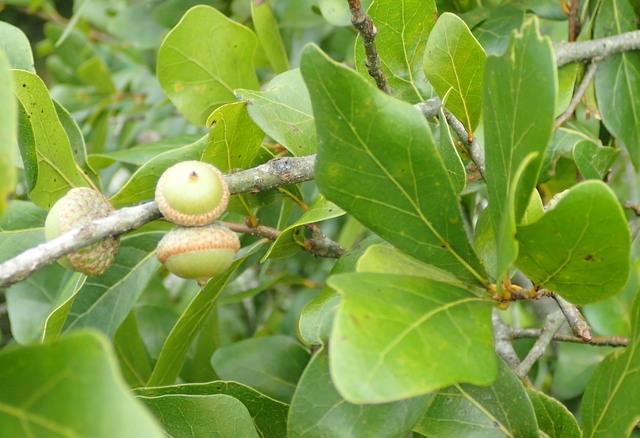Myrtle Oak
(Quercus myrtifolia)
Myrtle Oak (Quercus myrtifolia)
/
/

mfeaver
CC BY 4.0
Image By:
mfeaver
Recorded By:
Copyright:
CC BY 4.0
Copyright Notice:
Photo by: mfeaver | License Type: CC BY 4.0 | License URL: http://creativecommons.org/licenses/by/4.0/ | Rights Holder: mfeaver | Publisher: iNaturalist | Date Created: 2021-08-24T08:27:34-07:00 |

















































Estimated Native Range
Summary
Quercus myrtifolia, commonly known as Myrtle Oak, is an evergreen tree or large shrub native to the coastal plains, sandhills, and scrub habitats of the Southeastern United States, particularly Florida. It typically grows to a height of 15-20 feet (5-6 meters) and a width of 8-10 feet (2.4-3 meters), with a dense, rounded canopy. The Myrtle Oak has small, leathery leaves that are dark green and shiny on the top, with paler undersides. It produces inconspicuous flowers in the spring, followed by small acorns that are valuable food sources for wildlife.
Myrtle Oak is valued for its adaptability to poor, sandy soils and its use in xeriscaping due to its drought tolerance. It is often used in native plant gardens, as a screen or hedge, and in restoration projects where its evergreen foliage provides year-round interest. This oak is relatively low-maintenance, requiring minimal watering once established and thriving in full sun to part shade. It is not commonly affected by serious pests or diseases, but oak wilt can be a concern. Myrtle Oak is not typically invasive, but its ability to thrive in nutrient-poor soils should be considered when planting in more fertile areas.CC BY-SA 4.0
Myrtle Oak is valued for its adaptability to poor, sandy soils and its use in xeriscaping due to its drought tolerance. It is often used in native plant gardens, as a screen or hedge, and in restoration projects where its evergreen foliage provides year-round interest. This oak is relatively low-maintenance, requiring minimal watering once established and thriving in full sun to part shade. It is not commonly affected by serious pests or diseases, but oak wilt can be a concern. Myrtle Oak is not typically invasive, but its ability to thrive in nutrient-poor soils should be considered when planting in more fertile areas.CC BY-SA 4.0
Plant Description
- Plant Type: Tree, Shrub
- Height: 15-20 feet
- Width: 8-10 feet
- Growth Rate: Slow
- Flower Color: N/A
- Flowering Season: Spring
- Leaf Retention: Evergreen
Growth Requirements
- Sun: Full Sun, Part Shade
- Water: Low, Medium
- Drainage: Medium
Common Uses
Bee Garden, Bird Garden, Border Plant, Butterfly Garden, Drought Tolerant, Low Maintenance, Rabbit Resistant, Salt Tolerant, Street Planting
Natural Habitat
Coastal plains, sandhills, and scrub habitats of the Southeastern United States, particularly Florida
Other Names
Common Names:
Scientific Names: , Quercus myrtifolia, Quercus nitida, Quercus phellos var. arenaria, Quercus myrtifolia f. ampla, Quercus aquatica var. myrtifolia, Quercus phellos var. myrtifolia,
GBIF Accepted Name: Quercus myrtifolia Willd.